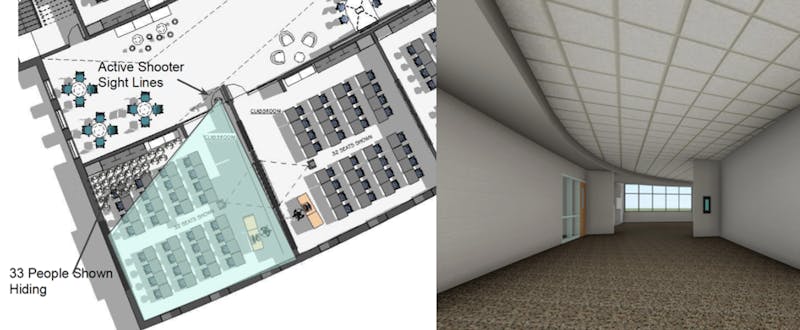Early in September, in Fruitport, Michigan, a new building at a local high school made headlines across the country. It had been designed for a single purpose: to try to mitigate the carnage of school shootings. There are no straight hallways lined with lockers at Fruitport High School. Its walls are curved, to reduce a gunman’s range and line of sight. Barriers jut out between lockers and classrooms, providing cover for students cowering from gunfire, and the doors to classrooms lock on demand, allowing children to hide from a gunman peering through their windows.
While many of these solutions are clever, and presented in good faith, high schools like Fruitport speak to a sobering new reality. Buildings are designed to last—they establish a sense of permanence and become the backdrop for our daily lives for decades, if not centuries, to come. That we are now designing them around school shootings is an architectural statement that we, as a country, have accepted carnage as a new normal—not a problem to be solved, merely mitigated.
Fruitport isn’t the only school to take up this approach. Sandy Hook Elementary, which reopened in 2016, pioneered many of these design concepts. It features curved hallways, impact-resistant glass, and special door locks that enable teachers to secure their classrooms quickly from the inside. More recent examples can be found in Shelbyville, Indiana, and Charleston, South Carolina. A school in Los Angeles County recently built a 20-foot wall of yellow metal around its entire perimeter to protect students from stray bullets. It’s not hard to understand why school administrators are looking for such solutions to the problem: Congress has passed no new gun control legislation since the 2012 Sandy Hook massacre (and, in fact, in the five years after the shooting, states passed more laws expanding access to guns than they did restricting access). Until legislators act, school shootings will only continue. Already, according to Slate, the school security industry rakes in $2.7 billion a year, and “those numbers keep rising.”

Schools can do more than normalize the now-routine epidemic of school shootings. Outside the United States, countries are taking school design in a strikingly different direction. Take, for example, Denmark’s Roskilde Festival Folk High School, which opened in 2019. Constructed within what was once an abandoned factory, the school features “boxes” staggered around a common area. Each contains workshops housing everything from recording studios to dance halls. In Bellaterra, Spain, primary schools are designed so that no child experiences the same scenery two years in a row; classrooms have different spatial layouts, geometric shapes, and views from their windows. And new schools across Europe have made use of existing structures and recycled materials to meet their sustainability goals.
Not only do American schools fall short in these areas, many, such as the schools in Baltimore, Maryland, where insufficient heating systems forced the city to send hundreds of students home last winter, also fail to meet their students’ most basic needs. More than half of American schools need extensive renovation. Such poor conditions, from unheated buildings to outdated textbooks, only serve to make the focus on preventing school shootings more absurd. What does it say about this country that instead of designing schools that better the lives of students, teachers, and the planet, taxpayers are spending millions each year to build schools that only reinforce and normalize their trauma and fear? When we prioritize the rights of guns above the rights of children, we as a culture are giving up on the idea of school as an enriching, joyous place. We’re building lasting monuments to Congress’s failure to act.
